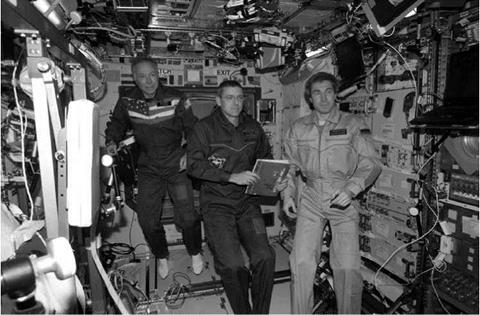SOYUZ TMA-7 DELIVERS THE EXPEDITION-12 CREW
 |
Soyuz TMA-7 was launched from Baikonur at 23:55, September 30, 2005, while ISS was over the Pacific Ocean, off the coast of Chile. McArthur and Tokarev were the Expedition-12 crew, and planned to spend 6 months on the station, while American Gregory Olsen was a paying passenger making a 10-day flight under a commercial contract with the Russians. A medical condition had grounded the American businessman from a Soyuz flight in 2004, but he returned to the programme the following year. Olsen insisted that he would be doing good work on the station and to that end he would perform a number of experiments for Russia and ESA.
The spacecraft docked to Pirs nadir at 01: 27, on October 3. Following pressure and leak checks the hatches between the two vehicles were opened at 04: 36. As with all new crews aboard the station, the newcomers were treated to the traditional Russian greeting of bread and salt upon their entry into the station. The usual safety briefing and emergency evacuation exercise followed before the new crew were allowed to settle in and Olsen’s couch liner was transferred to Soyuz TMA-6. American ISS commander Bill McArthur had arrived on ISS by Soyuz, but at that time, there was a faint possibility that he might have to stay on the station until a Shuttle could return him to Earth. During his occupation Russia’s original contract to supply Soyuz spacecraft for ISS would come to an end. If America could not find a away around the Iran Non-proliferation Act then the Russians would be under no legal obligation to return McArthur to Earth, even in the event of an emergency evacuation of the station! NASA made it clear that they expected to find a solution to the problem and negotiations were underway to overcome the problem.
A week of joint hand-over activities followed, along with the performance of a number of short-term experiments carried to the station in the new Soyuz. Meanwhile, Olsen completed his 8-day experiment programme. Krikalev and Olsen even filmed a television commercial for a Japanese company while on the station. On October 4, Phillips and McArthur reviewed the software for the SSRMS, before they performed several manoeuvres with the SSRMS itself the following day. The crew also took a message from Mikhail Fradkov, the Russian Prime Minister.
|
Figure 63. Expedition-12: Sergei Krikalev is on the right, with Expedition-12 crew member William McArthur in the centre and American spaceflight participant Gregory Olsen on the left. Olsen flew to the station in a Soyuz with the Expedition-12 crew and returned to Earth with the Expedition-11 crew. |
Following the official hand-over and final farewells Krikalev, Phillips, and Olsen sealed themselves inside Soyuz TMA-6. Prior to undocking the crew discussed a pressure leak between the re-entry module and the orbital module with engineers in Korolev. Krikalev finally undocked the Soyuz under manual control, at 17:49, and backed it away from the station. Throughout the separation manoeuvre and de-orbit burn the pressure leak continued to cause concern until the orbital module was jettisoned, at which time it ceased. The re-entry module landed at 21:09, on target 85 km northeast of Arkalik. The Expedition-11 flight had lasted 179 days 23 minutes and Krikalev’s personal endurance record now stood at 803 days 9 hours 39 minutes. Phillips felt light-headed after being helped out of the spacecraft by the recovery forces, but could not remember afterwards if he actually blacked out. The long- duration crew were subjected to the usual 45-day medical rehabilitation. Olsen had been in flight for 9 days 21 hours 15 minutes. At a post-flight press conference he repeated his dislike of the term “space tourist’’, used by much of the media to describe commercial passengers on Soyuz taxi flights. He explained, “I dedicated 2 years of my life to this. It’s not a hop-on-and-go kind of thing.’’
Meanwhile, McArthur had described his hopes for the Expedition-12 increment before launching to the station, “Above all that we launch and land safely; that we conduct this mission in a safe manner. Having said that, I think for it to be considered a success my criteria is that we will complete meaningful science during our stay, and that we will leave the Station more capable than we found it.”
During October, the Russian government approved funding for the national space programme through 2015. It was supposed to include the joint development, with ESA, of the Kliper spacecraft and the development by Krunichev of the new Multi-purpose Science Module to be launched to the Russian sector of ISS.











